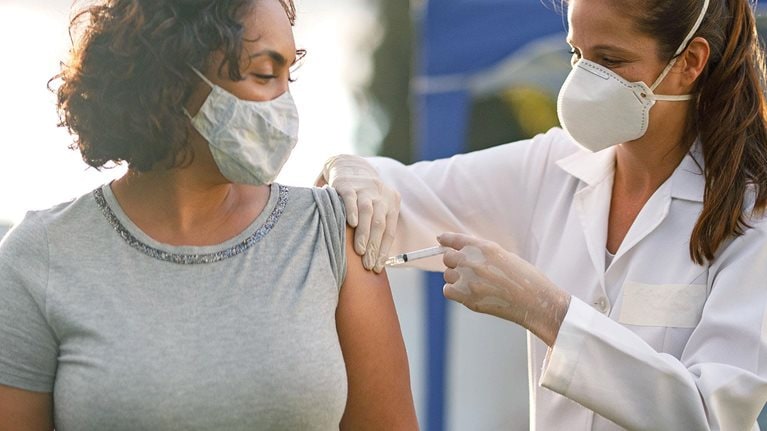Following the declaration of the COVID-19 public health emergency (PHE) in January 2020, the US government took unprecedented actions to support public health and stimulate the economy, including investing $4.4 trillion through multiple legislative packages1 and implementing more than 200 regulatory waivers under the PHE.2 These measures had a substantial impact on the entire US healthcare ecosystem, helping to stimulate testing and vaccination efforts, expand coverage and access to care, and support providers as they faced unprecedented challenges.
More than three years later, with the public health emergency expiring, much of the funding and flexibility that helped expand testing, vaccination, coverage, and access to care is also coming to an end (see table). The current administration has announced plans to end the PHE on May 11, 2023.3 Although Congress has recently extended certain accommodations through 2024 (for example, Medicare telehealth flexibilities and the Acute Hospital Care at Home program), the federal government is set to continue phasing out a majority of the funding and regulatory support initiatives currently in place, with many expiring concurrent with the end of the PHE. Also ending is a provision that had increased federal funding by 6.2 percent to provide incentives for state Medicaid agencies to keep individuals enrolled in the program (forgoing eligibility redeterminations). While redeterminations and increased federal funding were previously tied to the PHE, Congress is now allowing states to redetermine Medicaid eligibility as of April 2023 (states have some flexibility with when to start), and it is gradually reducing the additional funding throughout 2023.4


The impending changes in federal relief dollars (for example, the 20 percent increase in Medicare inpatient payments for COVID-19 treatment5) and reductions in care delivery and workforce flexibilities (such as the expanded scope of practice for non-physicians) will have broad implications for private stakeholders.
This article examines the federal government’s expanded role during the pandemic, the changes coming with the expiration of PHE, the impact and potential implications of these changes for private stakeholders, and how stakeholders may respond. For example:
- Providers could double down on operational efficiencies to mitigate additional financial hardships that they were already facing due to rising costs.
- Payers could prepare for shifts in enrollment and negotiate new contracts for items and services that had been temporarily covered by the federal government.
- Manufacturers and distributors could adjust their operations in anticipation of increased demand uncertainty.
Regardless of the specific actions they take, these affected stakeholders would likely benefit from responding quickly and decisively to their new environment.
The federal government’s role in the pandemic, and what may change
The federal government implemented a wide range of COVID-19 pandemic interventions, from vaccination, testing, treatment, and access to care delivery and healthcare coverage. In total, the government spent hundreds of billions of dollars—including more than $30 billion on vaccines,6 $50 billion on testing and contact tracing,7 and more than $170 billion in provider relief funding8—and adjusted hundreds of regulatory requirements to enable the US health system to respond to the pandemic. Healthcare industry stakeholders that have benefited from these funding opportunities and regulatory adjustments can consider how to respond to their planned rollback.9
Vaccination. The US government has played a substantial role in COVID-19 vaccine development, procurement, and distribution, investing more than $30 billion in total while accelerating regulatory approval processes to authorize three vaccines by early 2021 through Operation Warp Speed (OWS) and other initiatives.10 As of March 2023, the federal government had prepurchased 1.2 billion doses of the Pfizer and Moderna vaccines.11 Although the government paid for the costs of the vaccines, it required commercial payers, Medicare, Medicaid, and other programs to cover the costs of administering them.
Upon expiration of the PHE, Medicare and private payer in-network coverage for vaccination will continue, though patients may see out-of-pocket costs associated with vaccine administration. Medicaid will continue coverage for at least a year after the PHE ends. The government recently announced it will allocate $1.1 billion in additional funds that will provide vaccines for the uninsured through at least a portion of 2024.12 With payers required to cover vaccines and waning federal funding and vaccine provisioning, payers will assume new costs to cover COVID-19 vaccination. Both payers and manufacturers will need to negotiate contracts for vaccines that have to date been largely funded by the federal government.
Testing. The US government also played a critical role in COVID-19 testing and tracing. Appropriating more than $50 billion for COVID-19 testing and contact tracing,13 the government mailed more than 700 million at-home tests,14 expedited the tests’ regulatory authorization process, subsidized testing for the uninsured ($11 billion),15 provided tests directly to schools ($10 billion16) and to American households ($6 billion17), and helped to set up a coordinated surveillance and reporting system, including testing sites that are free to use.
The end of the PHE may limit the federal government’s continued investment in prepurchasing and providing tests. Funding for testing uninsured individuals18 expired March 22, 2022, prompting the administration to warn that it no longer had adequate funding to replenish the national stockpile of at-home tests.19 Medicare and Medicaid will continue to cover test charges for the calendar year following the end of PHE.20 As an essential health benefit, COVID-19 tests will be required coverage for individual and small group private payers,21 and other private payers are likely to cover some tests (for example, they may cover PCR but not home-based antigen tests). But testing coverage requirements for large group payers will end along with the PHE. Although private payers have been covering at least a portion of COVID-19 testing costs throughout the pandemic and patient demand for testing has declined, payers can anticipate and prepare for a potential increase in the proportion of testing-related claims as federal provision of tests and testing sites diminishes.
Treatment. The US government has also played a role in the treatment of patients with COVID-19, including by developing and providing therapeutics, increasing funding for patient care, and expanding care flexibility. For instance, in the first two months of 2022, the US government provided more than 2.5 million COVID-19 treatments and therapies to US states.22 Federal investment included therapeutic drug development and manufacturing,23 fast-tracked regulatory approval,24 drug procurement and distribution,25 and support for providers caring for COVID-19 patients (more than $20 billion for Medicare enrollees26 and $25 billion for the uninsured27).
Beyond existing grants, there are no publicly announced plans for additional federal funding, advanced purchasing, or procurement of COVID-19 therapeutics, although the Biden administration has requested more funding from Congress.28 Additionally, Medicare is set to impose Part B cost sharing (normally 20 percent) for monoclonal therapeutics in January the year after the Food and Drug Administration’s emergency use authorization (EUA) expires,29 and treatment coverage requirements for Medicaid enrollees will end one year after the PHE expires.30 If government coverage ceases, private payers will likely need to make coverage decisions about these therapeutics based on use patterns, clinical benefit, and patient demand. Providers and payers would also need to negotiate and enter contracts to directly procure therapeutics from manufacturers and distributors, and prepare for potential cost increases.
Access to care delivery. To facilitate greater access to care for the US population during the COVID-19 pandemic, the federal government supported strained providers by providing financial assistance, staffing and material resources, and flexibility in care delivery models.
Financial assistance came in the form of increased payments, loans, and reduced reimbursement sequestration. Increased payments included the 20 percent diagnosis-related group (DRG) add-on for COVID-19 patients31; the CARES Act, which freed up $150 billion in federal aid32; and nearly $180 billion in provider relief funding provided by the Health Resources & Services Administration (HRSA).33 The Centers for Medicare & Medicaid Services (CMS) provided more than $107 billion in COVID-19 Accelerated and Advanced Payment (CAAP) loans.34 The federal government delayed the 2 percent Medicare sequestration, which went fully back into effect in July 2022.35 Federal Emergency Management Agency employees deployed by the government offered staffing relief at hospitals and schools and provided much-needed COVID-19 supplies and infrastructure (such as ventilators; personal protective equipment; testing, screening, and cleaning supplies; and temporary barriers) as well as related labor costs (for example, temporary nursing care and overtime).
Finally, the federal government temporarily waived regulations that made it challenging to access care in an era of physical distancing and prevented hospitals from operating at capacity. Medicare coverage was expanded to telehealth services for the first time, and more than 200 waivers and modifications were implemented, including site-of-care and capacity expansions that gave hospitals flexibility in using hospital space.36 Additional waivers expanded the scope of practice for non-physicians and loosened hospital reporting requirements.
The uncertain future of government coverage and financial support for care related to COVID-19 may prompt providers and patients to prepare for a greater out-of-pocket burden for such services and treatment. Upon expiration of the PHE, hospitals will no longer receive the 20 percent DRG add-on for COVID-19 patients.37 While Medicare coverage of audio-only services for mental health was made permanent, most other telehealth waivers are set to expire at the end of 2024. Of particular importance will be the reduction of site-of-care and workforce flexibility, including expanded scope of practice for non-physicians.
Healthcare coverage. The COVID-19 pandemic ushered in an economic downturn following a decade of growth in US payroll employment.38 Between January and April 2020, 22 million Americans lost their jobs, and the US unemployment rate surged from 3.5 to 14.8 percent (by July 2022 the US economy had regained the number of jobs lost).39 Job losses and furloughs led to losses in employer-sponsored health coverage and the purchasing power to participate in healthcare exchanges.40 In response, the federal government intervened to expand coverage and fund governmental programs, including state Medicaid programs. This helped contribute to a historically low uninsured rate of 8.9 percent in the third quarter of 2021.41
The federal government intervened in the following ways to increase healthcare coverage throughout the pandemic: protecting Medicaid enrollees from disenrollment through most of the PHE,42 opening a special enrollment period for residents of the 36 states that use the US health insurance marketplace to secure health coverage, and providing federal subsidies to offset the cost of COVID-19 care to states (for example, via an additional 6.2 percent in federal medical assistance percentage, or FMAP, for non-expansion populations and 100 percent FMAP for states providing COVID-19-related Medicaid coverage to the uninsured) and to individuals (for example, via premium tax credits through the American Rescue Plan and the Inflation Reduction Acts).43
The 6.2 percent enhanced FMAP—which provided approximately $100.4 billion in additional funding to states from fiscal year 2020 to fiscal year 2022—began to decrease on April 1, 2023, and will phase out through the rest of the calendar year.44 Additionally, the 100 percent FMAP for the 15 states that have opted into providing COVID-19-related Medicaid coverage for the uninsured will end on the last date of the month that the PHE ends.45 Also, as of April 1, 2023, states may restart redetermination and disenrollment, which could lead to a potential 5 to 20 percent drop in Medicaid enrollment.46
The impact and potential implications for private stakeholders
As the unprecedented level of federal government COVID-19 pandemic support phases out, private stakeholders could strategically plan for their new responsibilities (exhibit).

Providers. Faced with rising operating costs and inflation, providers may find the time is right to take on operational efficiency programs to mitigate the additional financial impact of the loss of provider relief funds, loans, and the 20 percent DRG add-on. A reduction in Medicaid enrollment following the restart of Medicaid redeterminations may also affect reimbursement dynamics across some markets. The regulatory landscape will continue to influence provider investment decisions as many systems seek to expand ambulatory and telehealth service offerings. Telehealth has spurred huge consumer uptake and provider investment already.47 Congress recently extended many of the Medicare telehealth flexibilities and the Hospital Without Walls waiver through 2024.48 However, other related practitioner eligibility expansions are set to expire with the end of the PHE, which may affect providers’ ability to leverage alternative care settings for their patients. In a tight healthcare labor market, it is particularly important for providers to prepare for the rollback of site-of-care and workforce flexibilities (such as expanded scope of practice for non-physicians).
Private payers. Private payers will be required to absorb the costs of COVID-19 vaccination, testing, and treatment that were previously shouldered by the federal government. A likely increase in claim volume related to treatment, testing, and vaccination stresses the importance of use management efforts, particularly in the context of ongoing COVID-19 waves. Payers may also see higher costs related to vaccine administration. Finally, with the drop in Medicaid enrollment related to the resumption of Medicaid redeterminations,49 private payers on the exchanges should prepare for a potential increase in enrollment. An estimated one-third of beneficiaries no longer eligible for Medicaid will qualify for subsidies on the exchanges.50
Manufacturers and the healthcare industrial base. Manufacturers of COVID-19-related products will face uncertainty in demand as federal prepurchasing recedes and the regulatory climate reverts to pre-EUA requirements. Manufacturers that manage large federal contracts may need to prepare to juggle a higher number of smaller contracts (for example, with health systems and retail pharmacies) to maintain production levels. Manufacturers may also shift to seasonal production of COVID-19 supplies (the US Food and Drug Administration has suggested shifting boosters to a schedule similar to the flu shot)51 and pursue expansion into international markets if domestic demand remains unpredictable. The end of large-scale federal advance purchasing of COVID-19 products such as tests and vaccines could affect the country’s healthcare industrial base. Manufacturers will run the risk of having insufficient dedicated manufacturing capacity in the event of a potential future surge, which could lead to downstream public health consequences.52
Distributors. Waning federal involvement could have a more direct impact on companies involved in the distribution of COVID-19 vaccines, tests, and therapeutics than on other stakeholders. For example, health systems and pharmacies have had ongoing involvement in purchasing therapeutics and tests (particularly rapid tests). Distributors may now need to identify and secure contracts with manufacturers, hospitals, and pharmacies to take over the government’s previous role in provisioning products. At the same time, traditional distribution channels will likely be sufficient to deliver these products to consumers in a postpandemic era, assuming volume remains relatively predictable and care shifts back to traditional settings from, for example, vaccination drives at stadiums.
Since the COVID-19 public health emergency was declared in January 2020, the US government has invested trillions of dollars in public health and stimulus packages and implemented an unprecedented number of regulatory flexibilities to expand testing, vaccination, coverage, and access to care while supporting providers. As the public health emergency comes to an end, along with many corresponding funding and regulatory flexibilities, stakeholders have an opportunity to make strategic plans, respond quickly and decisively, and succeed in the new environment.


